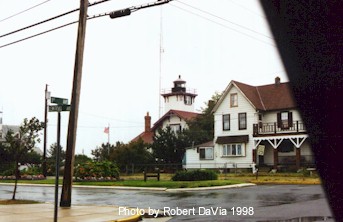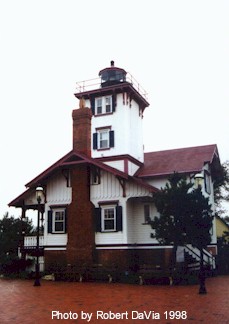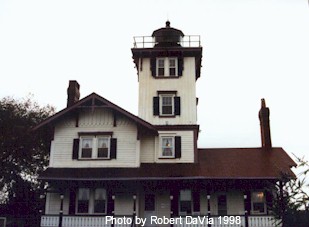

HEREFORD INLET LIGHTHOUSE AND GARDENS
Historic and picturesque Hereford Inlet Lighthouse, a beacon of safety and assurance to the 19th century mariner, has become a focal point for visitors and those who like to call this resort their summer or year-round vacation home. Overlooking the wide Hereford Inlet, which leads from the Atlantic Ocean to the famed Inter-Coastal Waterway, linking Maine to Florida, the site of the lighthouse once served as a life saving service

Begun in 1849 because of the increased use of the inlet by sailors the world over, local fishermen and their families were concerned enough to expand the Life Saving Service, which supplied men and boats for the assistance of sailors in time of trouble. Because of its strategic location, the Service was expanded and in 1871, Hereford Inlet Life Saving Station No. 36 was constructed. The Inlets use as a haven to mariners greatly increased as they became aware of the treacherous currents and ever-shifting sandbars that made travel off the Atlantic Coastline a challenging experience to even the accomplished sailor. The fact that Hereford Inlet is almost equidistant to Great Egg Harbor to the North and the mouth of Delaware Bay to the South made it most inviting and recognized as an important shelter for the vessels that plied the coastal waters. Whether they were in quest of the multitude of fish found in the area, or were engaged in cargo transport, sailing vessels found Hereford Inlet a safe haven and the Life Saving Station a welcome sight.
The site of Hereford Inlet Lighthouse was selected because it holds a prominent position in the dune area overlooking the mouth of the inlet. Known throughout the last century as the fishing village of Anglesea, the area was sparsely populated and over grown with the dense shrubbery, berry bushes, cedar, pine and holly trees. It took from 1849, when the Life Saving Service was started, until 1871 for Congress to recognize the need for a larger more permanent facility at Anglesea. It was on June 10, 1872, that Congress finally enacted legislation to finance a "small light-say of the fourth order." The deed for the one and a half-acre site bears the date of July 7, 1873, and is from Humphrey S. Cresse and his wife to the United States for the purchase price of $150. The station was constructed under the supervision of the U.S. Army Corps of Engineers. Of Victorian design, the Lighthouse was considered more sophisticated than was characteristic of other lighthouses of the era, creating a picturesque structure featuring five fireplaces. It was truly a comfortable home to the Lighthouse keeper and his family.
On May 11, 1874, a "NOTICE TO MARINERS" formally announced the start of operation of the light. The light is located on the North end of the Island known as Five Mile Beach, at latitude 39 degrees and longitude 74 degrees, 47 minutes. The tower height is 49 ½ feet with the light elevation rising to 57 feet above sea level. The light is visible at a distance of at least 13 nautical miles.
John Marsh was the first lighthouse keeper. He was in the post less than three months when he drowned in an accident as his boat capsized while returning to Anglesea from the mainland. John Nick took over as keeper and manned the light for four years, when in 1878, Captain Freeling H. Hewitt became the guardian of the light until 1918. It was under the auspices of Capt. Hewitt that local fishermen and their families gathered for a Baptist ceremony, which was the first formal religious service conducted on Five Mile Beach Island.
The Lighthouse stood firm against the onslaught of the winds, rains and tides for 40 years at its original location. A severe storm in August of 1913 significantly damaged the foundation, requiring it to be moved westward about 150 feet. This task was completed in 1914. For the next 50 years, the Lighthouse continued in operation, but in 1964 an automatic iron light tower was built, replacing the old light but displacing the light keeper. In April 1986, the light was again placed inside the lighthouse. In 1963 the entire property was transferred to the control of the New Jersey Marine Police, who used other buildings on the property but boarded up the lighthouse. On September 2, 1982, a lease was signed whereby the New Jersey Department of Environmental Protection turned over stewardship of the lighthouse to the city of North Wildwood.

Restoration of the historic yet neglected building was immediately begun. After only ten months of intense work, on July 1, 1983, a portion of the restored building was opened for use as a North Wildwood Tourist Information Center. Hundreds of public spirited citizens who helped raise funds for the restoration and contributed time, talent, energy and materials, were on hand to celebrate the official reopening of the historic landmark for public use. Hereford Inlet Lighthouse was listed in the National Registry of Historic Places on September 20, 1977 A park project to improve the lighthouse grounds was accomplished in 1986 under the sponsorship of the city of the New Jersey State Green Acres Trust. Further refurbishing of the structure is being done on a continuing basis by members of the Hereford Inlet Lighthouse Commission and volunteers from the community. In addition, with financial assistance from the Cape May County Cultural & Heritage Commission and the New Jersey State Council on the Arts, prize winning paintings have been purchased and will eventually be hung in the lighthouse when plans are complete for converting a large portion of it into a nautical museum.
The Hereford Inlet Lighthouse is located at First and Central
Avenues, in North Wildwood, New Jersey.
Phone (609) 522-4520 or 522-2030 for
opening dates and hours.
Return to the New Jersey State Page
Return to the: Alphabetical Listing or the Listing by States